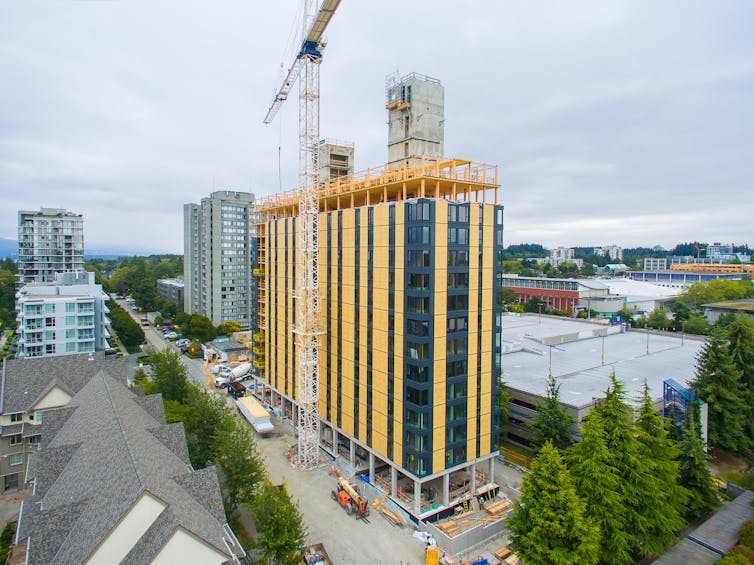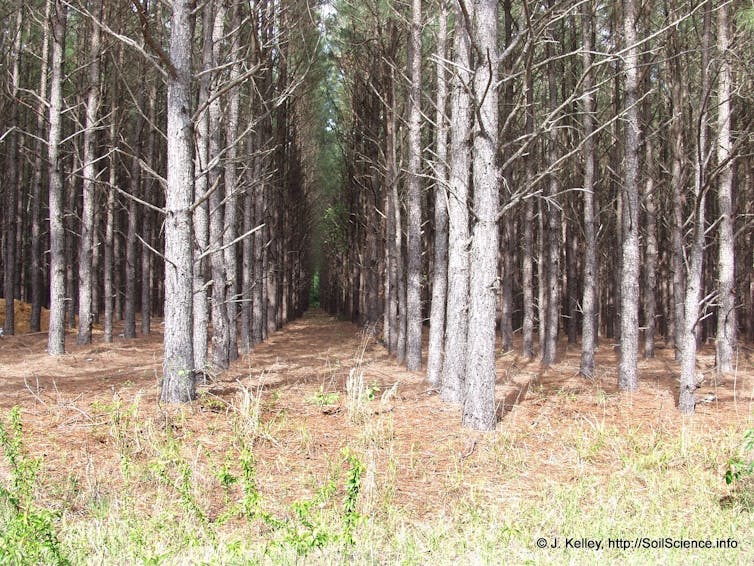Have a look at this piece published in The Conversation:
High rises made out of wood? What matters in whether ‘mass timber’ buildings are sustainable
by Brent Sohngen
A material that’s been around since people built shelters – wood – is increasingly being proposed for low- and mid-rise buildings.
Companies behind these “mass timber” projects say that wood is a lower-carbon alternative to steel or concrete and brings other benefits, such as faster construction time and lower cost than concrete and steel. Advocates say the wood materials, made of compressed layers of wood with glue, offer good fire safety as well.
As an economist who studies forestry and natural resources, I took an interest in this building trend when I heard that a local bar on campus was going to be replaced by a 13-story building made out of wood.
I see any increase in the use of wood in buildings as positive for reducing the substantial carbon footprint of buildings. But it is critical to consider where wood is sourced and whether forests are managed sustainably.
One way that researchers assess the environmental footprint of a product or service is called a life-cycle analysis, which calculates the cradle-to-grave impact.
One life-cycle analysis found that using mass timber in a 12-story building in Oregon had an 18% lower global warming impact compared with constructing the building with steel-reinforced concrete. The carbon emissions benefits are even greater when comparing timber with steel for low- and mid-rise buildings. In these studies, the global warming benefits mostly result from lower emissions in sourcing, transporting and manufacturing the material for these large wood buildings, compared with steel or concrete components, rather than efficiencies in heating or cooling or disposal of the materials at the end of the building’s lifespan.
On a global level, the raw material for mass timber – forests – absorb large amounts of carbon dioxide from the atmosphere, making them an important carbon “sink.”

Tree cutting is one of the most widespread disturbances in forests, yet, after accounting for all harvesting, fires, land use change and other disturbances, forests in the United States still remove a net 754 million tons of CO2 per year from the atmosphere, an amount equivalent to 13.5% of U.S. emissions. Globally, the picture is similar, with forest growth removing 2.6 billion tons of CO2 more from the atmosphere than the combined effect of all wood harvesting, deforestation, forest fires and other disturbances.
Although today forests are a net CO2 sink in the U.S. – taking in more carbon from the atmosphere than released through disturbance – before the middle of the last century, they were a big source of carbon emissions. Back then, farmers converted land to agriculture, foresters cut old-growth trees to produce lumber, and forest fires raged. Carbon losses in the U.S. were so large that land-based emissions around the turn of the 20th century were on par with emissions from deforestation in tropical regions today.
Over the past 100 years, the trend has reversed, as forests have removed far more CO2 from the atmosphere than they have released. One reason for this transition has been a sustained increase in crop yields, which has allowed for greater farm output on fewer acres. As a result, grain prices fell in real terms and farmers abandoned less productive lands, allowing forests to return. These regrowing forests, in turn, removed carbon from the atmosphere.
Abandonment was not the only reason trees regrew in the U.S. Even as foresters were still sawing their way through old-growth stocks in the first half of the 1900s, some foresighted forest landowners began planting trees because timber scarcity was growing, as evidenced by timber prices rising at 3% to 4% per year. By the 1950s and 1960s, over a million acres were being planted annually in the U.S., and today, the area planted is double that.
Economics of forest management
To examine whether wood is sustainably sourced, rather than contributing to higher carbon emissions, it is instructive to consider the economics of forest management.
A shift toward using wood rather than other materials in low- to mid-rise building designs will drive demand for wood products, resulting in both more harvesting and more planting. Any increase in harvesting carries risk, including an increase in carbon emissions, habitat loss, and other impacts. Perhaps the most evident effects happen when surging demand causes logging in sensitive ecosystems, critical habitats or old-growth forests. If lost, ecosystem services like biodiversity are often impossible to replace.
Carbon may be less of a worry because it can be returned to forests through regrowth. However, some critics maintain that harvests deposit CO2 in the atmosphere for the period between a timber harvest and forest regrowth, resulting in a massive CO2 emission.

There is considerable debate about this “excess” emissions hypothesis. Other research into the effects of increased wood demand illustrates that both harvesting and regeneration increase when demand rises. When timber investments are modeled alongside harvesting, carbon stocks in forested lands increase when wood demand ratchets up. This finding is not new. The example of the last century reveals that elevated timber demand and higher wood product prices strengthen incentives for landowners to intensively manage commercial forests – plant more acres, improve varieties, shift species mixes, fertilize, control drainage and manage competition.
The sustainability of mass timber will also be determined by which forests supply this new demand. It is unlikely that much of this new harvesting will happen on the 42% of U.S. forests owned by various units of government.. Many of these forests are either administratively protected – for example, as a wilderness area – or are remote and costly to access. Where cutting is allowed, logging is slowed by the considerable planning, impact assessment and public involvement required.
Even many private landowners have gotten into the habit of protecting for the purpose of environmental services. Today, over 37 million acres of private land in the U.S. are enrolled in conservation easements, which limit what current and future owners can do with their land. Not all of these protected lands are forests, but where they are, new demands for mass timber are unlikely to result in more harvesting.
Aside from these legally protected lands, forest protection happens in many private forests simply because many forest owners are inattentive or they have strong preferences for wildlife and benefits other than timber revenue. As a result, research has found that nonindustrial landowners as a whole are unlikely to expand cutting even if demand does grow substantively.
Role of planted commercial forests
At the other end of the spectrum, industrial interests own just 20% of U.S. forests, but supply 46% of the nation’s timber. An overwhelming share of these forests are managed intensively with plantations. Tree planting is so prevalent that industrial owners account for 60% of private planted forests, defined as those that are artificially regenerated via planting or seeding.
Intensive management explains how so few industrial forests can support such expansive harvesting. If demand rises, these owners will have strong incentives to increase harvests. Yet because forests are a valued asset, they will also grow more and bigger trees with new plantings and intensified management.
One effect of climate change on forestry is that rising carbon dioxide levels have increased forest growth through higher rates of photosynthesis. A 2022 paper I co-authored found that elevated levels of CO2 had a particularly large effect on wood volume in younger, planted stands. Not only did forest plantations contain more wood volume at the same age than natural stands, but our study estimated that over the past 50 years, planted stands gained 62% more volume from this carbon “fertilization”. The number of trees per acre did not change substantively over this same time period, so most of this wood volume increase resulted in bigger trees.
Between 1997 and 2017, industrial owners accounted for eight out of every 10 new hectares of planted forests on private land as they doubled plantation area. No one will confuse these forests for old-growth forests, but from a commercial perspective, planted trees have become the lowest cost source of timber. They also relieve pressure on natural stands.
More critically for the atmosphere, expanding the area of young, fast-growing stands enhances the overall carbon sink of forests and brings an incentive to manage forests that serve the built environment.